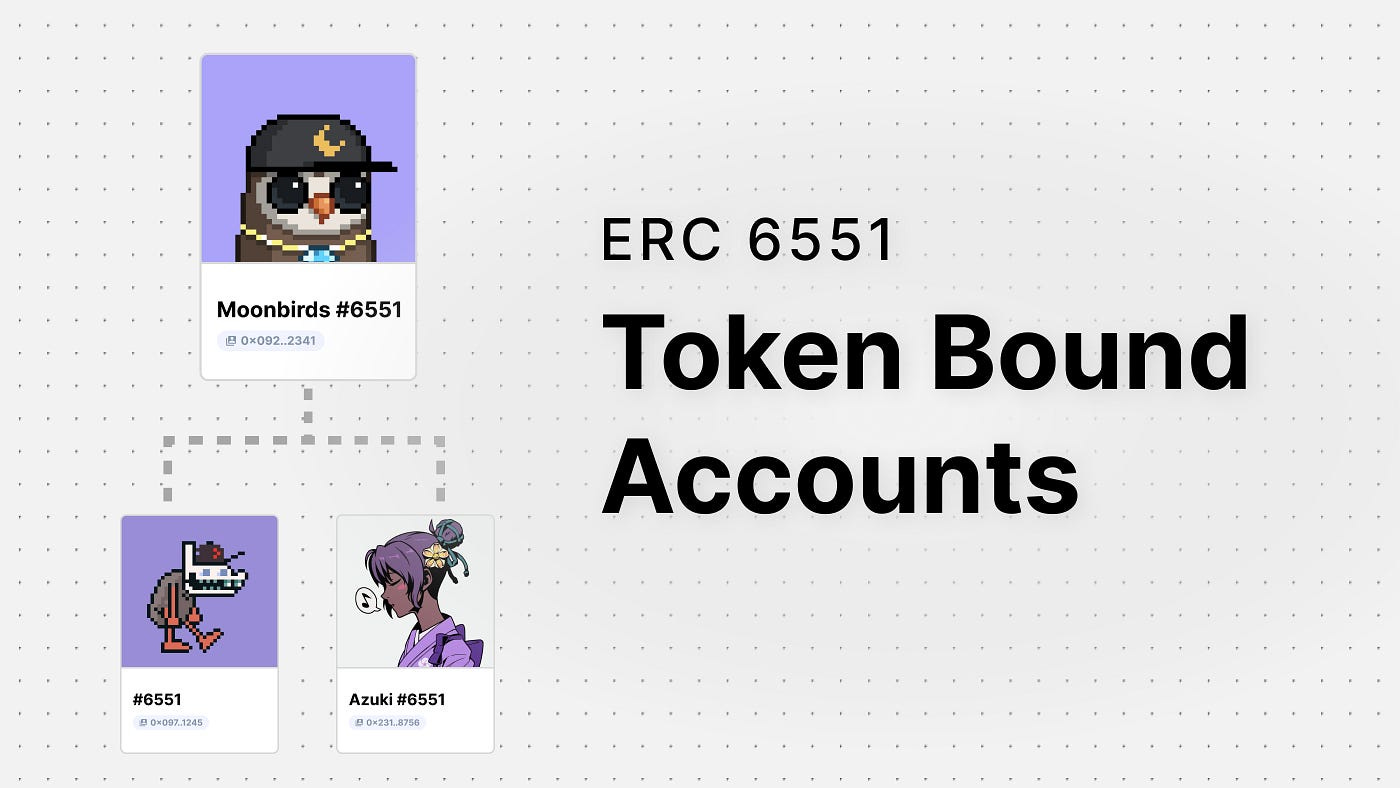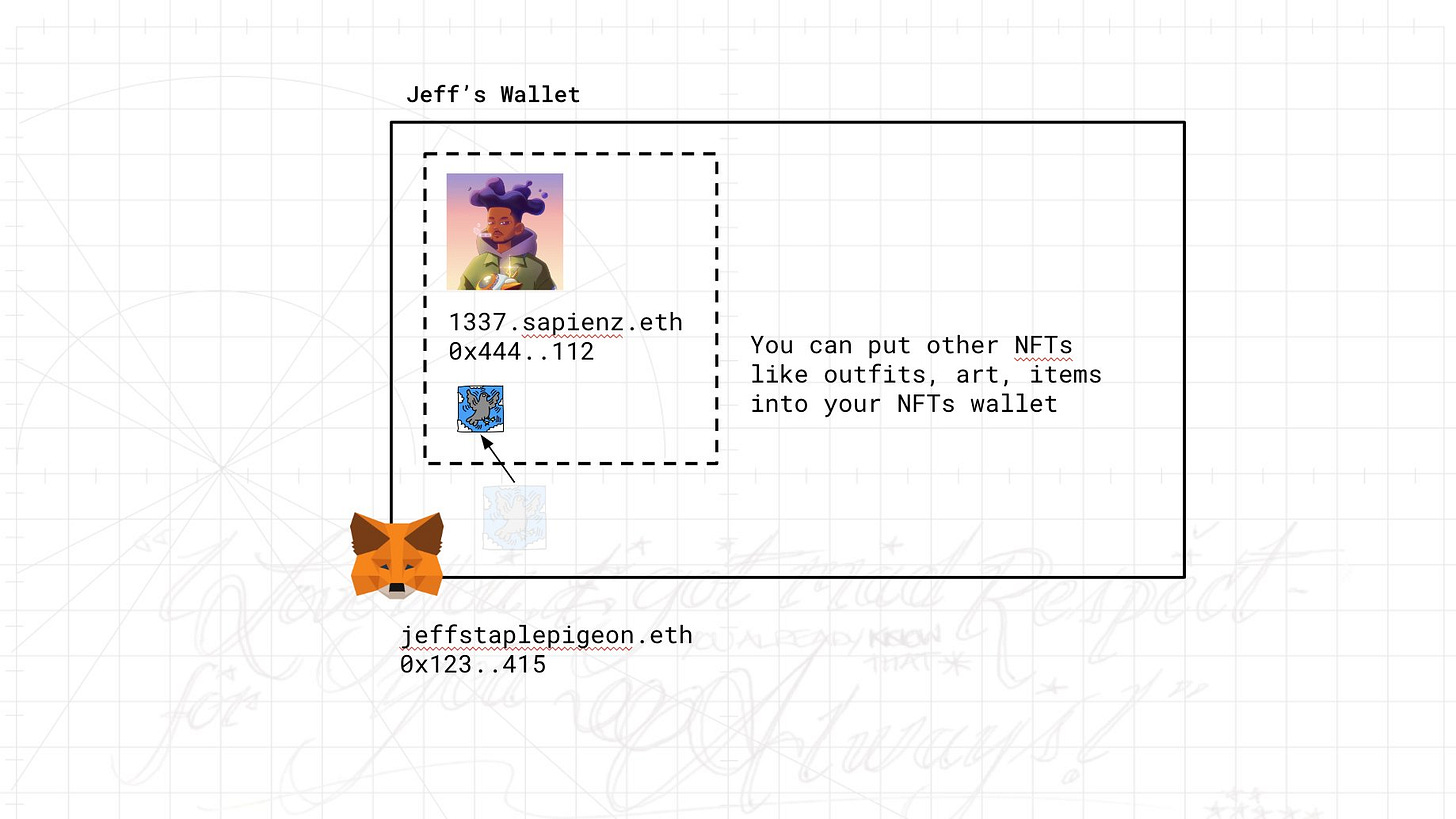[74] Composability Rules Everything: ERC6551 and Token Bound Accounts
[ERC6551, Token Bound Accounts, Digital First Society]
GM Readers!
I went down the rabbit hole, researching a new Web3 building block called ERC6551 for hours. ERC6551 allows NFTs to own other NFTs. Let’s explore why this is an important building block and ponder where this might take us as we continue to evolve into a digital first society.
-LJW
(P.S. For the summary and further breakdown of this essay, follow me on Twitter)
Relevant Essay:
🎨 Life in Color Relevant Essays: [The 42nd Fold] + [NFTs: Place on the Internet]
🎨 Background Reading: [Benny Giang, CoAuthor of ERC6551, Thread] + [ERC 6551 Launch Post by Benny and team]
SHAMELESS Ask:
🙏 Share Life in Color with a friend and ask them to subscribe
🙏 Share on Twitter / Linkedin with a short note
🙏 Share on your company Slack / Teams channels and communities
Amidst the bear market, builders still continue to ship foundational lego blocks that will shape the future of Web3 and our digital society.
Since Web3 runs on composability, and composability enables compounding, each of the lego blocks that push this thesis forward is important to understand.
Refresher: in a composable system, different components can be selected and assembled in various combinations to achieve a specific goal. In software development, composability refers to the ability to combine functionality or leverage other code to build something else.
Composability enables compounding because it decreases the cost of innovation and experimentation across the industry.
One lego block that was recently released is ERC 6551.
🤔
ERC6551: Token Bound Accounts
ERC6551 gives every NFT a crypto wallet. This enables the NFT to do anything that owning a wallet allows them to do.

With ERC6551, an NFT can own other NFTs, digital assets and digital items. The NFT can also participate in governance, sign messages and participate as an “entity” and standalone unit in any area that a person with a wallet can participate in.
In the launch article by Benny Giang (the cofounder of Crypto Kitties and one of the main authors on ERC6551 standard), he highlighted a few use cases that ERC6551 enables for NFTs:
Equipping digital outfits and items
ERC 20 token earning/airdrop models
POAPS or badges earned by participation
Trading entire collections as a single unit
NFTs as on chain identities with the ability to layer on social network models
One of the first use cases that is available today is allowing NFTs that represent profile pictures and images of characters to be more dynamic.

Since PFPs are already used to represent our digital identity online, it’s logical that the next form of expression is making them more dynamic. This means, allowing the NFT image to own other images that they can equip — sort of like digital fashion items for your avatar.
Since we don’t look one way all the time in real life, we shouldn’t look one way all the time in the digital world.
But this is just one of the first use cases. We can abstract this up a level and think of ERC6551 as allowing any digital thing to own another thing.
This brings us to a more philosophical exploration of what ERC6551 enables.
🤔
Disruptive Things Start as Toys
One of Chris Dixon’s seminal frameworks is that disruptive things start out looking like toys… “Disruptive technologies are dismissed as toys because when they are first launched they “undershoot” user needs.”
The framework highlights that when new things are launched, non-believers think the initial use case (the “toy use case”) is representative of all the future innovation the new thing might bring. People fail to see the compounding that is enabled by the new thing.
Since ERC6551 is open source, many builders, creators and tinkerers are experimenting and developing new use cases based on ERC6551.
This all contributes to the broader composability and compounding of Web3. Each building block might seem niche — just another novel idea … but compounding through composability requires different building blocks to come together to enable something game changing.
This does not mean every product that looks like a toy will turn out to be the next big thing. To distinguish toys that are disruptive from toys that will remain just toys, you need to look at products as processes. Obviously, products get better inasmuch as the designer adds features, but this is a relatively weak force. Much more powerful are external forces: microchips getting cheaper, bandwidth becoming ubiquitous, mobile devices getting smarter, etc. For a product to be disruptive it needs to be designed to ride these changes up the utility curve.
So… what are the external forces that might propel the adoption of ERC6551 and the products built on top of it?
There are two (related) mega trends to note here:
We continue to move more of our lives online — the things we own and how we represent our identity digitally.
We are adopting AI at an accelerating rate. In the digital world (where we spend most of our time), the presence of AI will highlight new questions for us — what does the concept of scarcity look like? How do we know what’s real?
Provenance is important for both of these trends. The concept of provenance refers to the ability to track and authenticate the history and lifecycle of an asset.
ERC6551 enables provenance at the NFT level.
🤔
ERC6551: Identity and Organization Primitives
What does any of this have to do with “NFTs owning other NFTs”?
If we think of NFTs like packets of data that are stored immutably on the blockchain, then any action that is taken in the digital world could be memorialized as an NFT on the blockchain.
For example, let’s imagine how this might work for a loyalty program.
You are a part of the loyalty program of a popular coffee chain. In that ecosystem, you have an NFT profile picture that represents you in that ecosystem’s digital space.
Because you are an active community member, you get rewarded with (different) NFTs that serve as badges for your accomplishments. Actions that you take, such as buying a coffee, engaging in a community contest, posting x-number of times in a forum, etc can all be memorialized as NFTs — think of these as digital receipts for your actions.
Those NFTs representing your accomplishments are normally sent to your wallet. But there is no direct link to the NFT profile picture, which means there is a break between your identity (the NFT profile picture) and the actions you took (digital receipts). Also, once you get more badges, the user experience around your wallet becomes pretty clunky.
With ERC6551, the NFTs that represent your participation in the loyalty program can be owned or attached to your NFT profile picture instead. And as you participate in different loyalty programs, with ERC6551, you have “different drawers for the receipts you receive across different ecosystems.”
The big idea is that ERC6551 enables provenance at the NFT level. With provenance enabled at the NFT level, anyone else can take this provenance information, further segment it and build other things on top.
For example, if another coffee chain wants to reward the NFTs that have collected a set number or specific types of badges from the first coffee chain, they can do so easily in a world with ERC6551.
🤔
So What?
So far we’ve only explored ERC6551 in the context of NFTs with the identity use case (profile pictures).
But what if in the future, NFTs weren’t only used for identity?
Remember NFTs are just data packets … so anything that can be reduced to data online which is to say that everything can be reduced to data … can be theoretically abstracted as an NFT.

In a digital world that is global in nature, we might have entire entities that are represented as NFTs, and the actions of those entities can be memorialized as additional NFTs they own, transparently on the blockchain.
This gives life to NFTs-as-a-standalone-entity concept. And this is sort of how things work in the real world today, except the organizing mechanism isn’t an NFT, but some other framework (think corporations, trusts, organizations, etc).
All this is to say, in the digital world, organization primitives and how we come together to interact with each other is critically important.
It’s all sort of one big organization and segmentation exercise at the end of the day and ERC6551 is a primitive that makes that a little easier.
🛟 Disclaimer:
This post is provided for educational and informational purposes only. Nothing written in this post should be taken as financial advice or advice of any kind. The author(s) may own some of the NFTs, art and/or collectibles mentioned in this post. The content of this post are the opinions of the authors and not representative of other parties.
Empower yourself, DYOR (do your own research).


I love the example here --> "there is a break between your identity (the NFT profile picture) and the actions you took (digital receipts)". This really illustrates a great problem solved by this new standard.